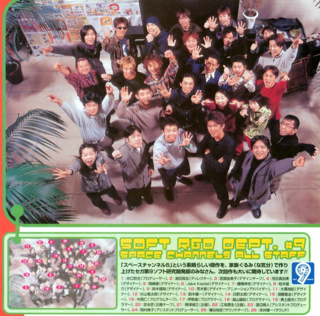Difference between revisions of "Space Channel 5/Development"
From Sega Retro
m (migrated content, inline) |
m (Text replacement - "{{back}}Category:Development " to "{{back}}Category:Development {{DevelopmentBob | missedreleases= }} ") |
||
| Line 1: | Line 1: | ||
{{back}}[[Category:Development]] | {{back}}[[Category:Development]] | ||
| + | {{DevelopmentBob | ||
| + | | missedreleases= | ||
| + | }} | ||
==Development== | ==Development== | ||
Revision as of 06:44, 29 April 2022
- Back to: Space Channel 5.
| Space Channel 5 development |
|---|
| Missed release date(s): |
Contents
Development

According to Tetsuya Mizuguchi, the Space Channel 5 project was born after a request from Sega to produce a game which appealed to "casual female gamers". Unaware that such a group in society existed, Mizuguchi spent much of the design phase interviewing young girls, ultimately coming to the conclusion that the puzzle genre was most suited to this demographic. However, in a bid to also appeal to a male audience as well, the game was designed to be competitive.
Space Channel 5 is primilary inspired by western culture of the 1960s, particularly a mix of fashion and espionage thriller movies such as James Bond. Its main theme, Mexican Flyer was originally released in 1965 (the same year Mizuguchi was born) by British composer and trumpeter, Ken Woodman.
Originally Space Channel 5 was said to simply be an interactive music video. Pressing buttons in time with the music would change the video, but little else would occur. Displeased by the lack of "fun", Tetsuya Mizuguchi demanded that elements inspired by the dance troupe, Stomp were implemented to liven up the gameplay. UGA's staff at the time struggled to comprehend some of the more radical ideas Mizuguchi put forward, so a pantomine was brought to UGA to lift spirits, ultimately inspiring the numerous "strike a pose" segments within the game.
Half way through production, Mizuguchi was contacted by Shuji Utsumi, who informed him that Michael Jackson was interested in taking part in the game. Utsumi had shown the star a 60-70% complete version of the game, set to be finalised within a month, and after some negotiations, "Space Michael" was put into the game. Mizuguchi and Utsumi would later found Q Entertainment in 2003.
Because the player has no control over Ulala's movement through stages, much of Space Channel 5 relies on pre-rendered backgrounds, leading to arguably more detailed visuals than what the Dreamcast could achieve in real-time.
Concept artwork
Promotional screenshots
Dreamcast version
PlayStation 2 version
References
| Space Channel 5 | |
|---|---|
|
Main page | Comparisons | Credits | Development | Magazine articles | Video coverage | Reception | Merchandise | Technical information | Bootlegs
Music: Space Channel 5 Ulala The Movie (1999) | Space Channel 5 Mexican Flyer (2000) | Space Channel 5 Planet Dance (2000) | Space Channel 5 Original Soundtrack (2000) | Mexican Flyer Remix Tracks Inspired by Space Channel 5 (2000)
Demos: Space Channel 5 Taikenban (1999)
Prototypes: 2000-04-20
| |








































































